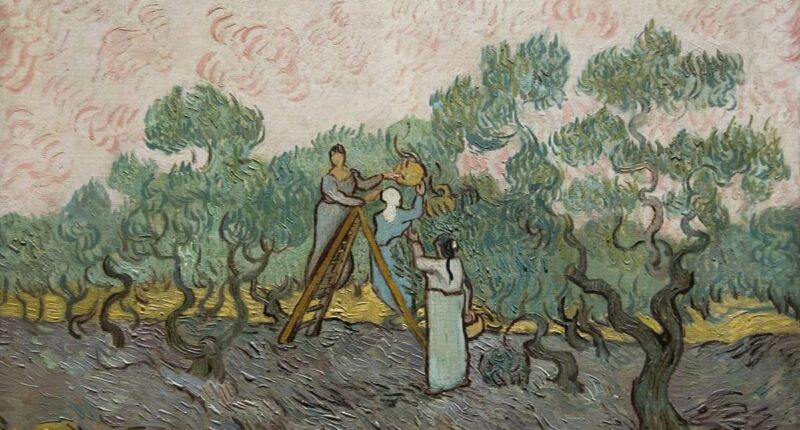Share this @internewscast.com
The Metropolitan Museum of Art finds itself embroiled in a legal battle as an heir of a wealthy Jewish couple seeks the return of a Vincent van Gogh painting, allegedly seized by Nazis at the onset of World War II.
Judith Anne Silver, the heir, has filed a lawsuit against both the Met and the Basil & Elise Goulandris Foundation. She contends that the institutions have neglected to acknowledge the painting’s troubled past and insists it should be returned to her family.
The legal action, initiated in the Federal District Court in Manhattan, also demands compensation exceeding $75,000 for the painting’s wrongful detention, alongside its market value, legal costs, and punitive damages.
The artwork in question, “Olive Picking,” was created by the renowned Dutch painter Vincent van Gogh in 1889. It captures the essence of van Gogh’s post-impressionist style, depicting three women harvesting olives, two of whom are perched on a ladder amid a verdant tree.
Throughout the decades, “Olive Picking” has passed through various hands. It was once owned by Fritz and Hedwig Stern, a Jewish couple residing in Munich, Germany. They acquired the painting in 1935 but were forced to relinquish it in December 1936, as the political climate intensified.
Olive Picking was owned by Fritz and Hedwig Stern, a Jewish couple who lived in Munich, Germany, until December 1936, a year after they purchased it.
The Sterns were forced to flee the country with their six children to save themselves from the Holocaust, and the Nazi government declared the precious painting as ‘German cultural property.’
Even though the Sterns had intended to take the painting with them, the Nazis prohibited them and said they would sell it on their behalf, according to the lawsuit.

The painting is titled Picking Olives and was painted by acclaimed artist Vincent van Gogh in 1889

Judith Anne Silver is suing the Met and a Greek foundation for acquiring a Vincent van Gogh painting that belonged to her family, Hedwig and Frederick Stern (Pictured with their child, Walter)

The Metropolitan Museum of Art (pictured) has been named in a recent lawsuit filed by the heir of a Jewish couple
After the painting was sold, the funds were put in a ‘blocked account’ and later confiscated by the Nazis, so the Sterns claim to have never seen the van Gogh again.
‘In the decades since the end of World War II, this Nazi-looted painting has been repeatedly and secretly trafficked, purchased and sold in and through New York,’ the complaint read.
The painting traveled to various locations after the war, first to Berlin and then to the US.
An art dealer named Justin Thannhauser had tracked the painting’s movements and acquired it to sell to New York socialites.
Vincent Astor, the infamous Manhattan businessman whose father died on the Titanic, purchased the painting from Thannhauser in 1948.
Vincent’s wife, Brooke, served on the Met’s Board of Trustees from 1964 to 1983, according to the complaint.
The Sterns had no idea the painting was in New York, and continued to pursue official claims in Germany until 1955 to get their prized possession back.
The Astors then cosigned the sale of the painting to the Knoedler Gallery that same year.

The Sterns were forced to flee their home (pictured) during the Nazi occupation of Germany

Throughout the years, the painting has traveled around the world and was obtained by multiple different owners before it landed at the Basil & Elise Goulandris Foundation in Athens (pictured)
In 1956, the Met acquired the painting from the gallery. The Met’s Curator for European Paintings at the time, Theodore Rousseau, Jr, approved the purchase for $125,000, according to the complaint.
The complaint alleges that Rousseau neglected to recognize that Nazis likely looted the painting.
Silver’s lawyers argued that Rousseau was ‘one of the world’s foremost experts on Nazi art looting,’ citing his tenure as a Lieutenant Commander in the US Navy during the war.
He also personally curated the Met’s van Gogh exhibition, which included 158 paintings by the artist.
Rousseau had served in the Office of Strategic Services during the war, where he authored a report for the Art Looting Investigation Unit.
The lawsuit stated that Rousseau was only one of three American officers working for the elite ALICU.
The museum then took steps to sell the painting in 1972, which the lawsuit alleges is, ‘further evidence that they knew or should have known that the painting had probably been looted by the Nazis.’

The Met’s Curator for European Paintings at the time, Theodore Rousseau, Jr (pictured), approved the purchase of the painting in 1956 for $125,000

The painting was then sold to Basil and Elise (pictured, left) Goulandris in 1972
The Met sold the painting to Basil and Elise Goulandris, wealthy Greek immigrants in the New York shipping industry.
‘Since acquiring the painting in 1972, through a series of transfers, the Goulandris family and its related entities have hidden and obscured the Painting’s ownership and location from Plaintiff,’ the lawsuit alleges.
Olive Picking still hangs in the Basil and Elise Goulandris Foundation museum in Athens, Greece.
‘To this day, the Goulandris Defendants continue to conceal how and when the BEG came into possession of the Painting; the Stern family’s ownership of the painting from 1935 to 1938; and the facts that the Nazis looted the painting from the Stern family, coerced the Sterns into selling it via a Nazi-appointed agent, and confiscated the proceeds of the sale,’ the lawsuit claims.

When the painting first arrived in the US, New York socialite Brooke Astor (pictured) acquired it, the lawsuit claims

The Met defended the decision to sell the painting and maintained they obtained it legally in a statement
In a statement to the New York Times about the complaint, the Met said: ‘While the Met respectfully stands by its position that this work entered the collection and was deaccessioned legally and well within all guidelines and policies, the museum welcomes and will consider any new information that comes to light.’
The Met also denied the allegations that Olive Picking was sold because of speculation that it was tied to Nazi looting.
The museum said it was sold because it ‘was deemed to be of lesser quality than other works of the same type in the collection.’
The Daily Mail has approached the Met and the Basil & Elise Goulandris Foundation.




